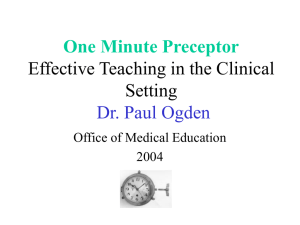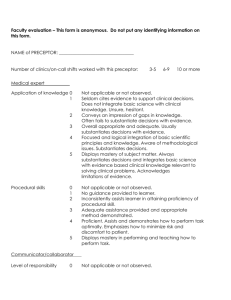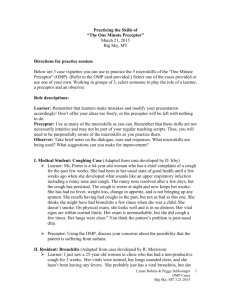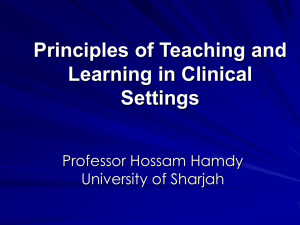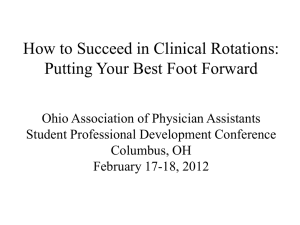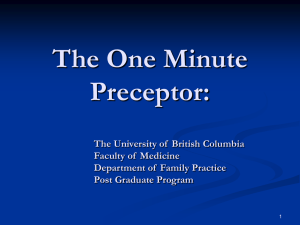Introduction to Teaching - Academy of Master Educators
advertisement
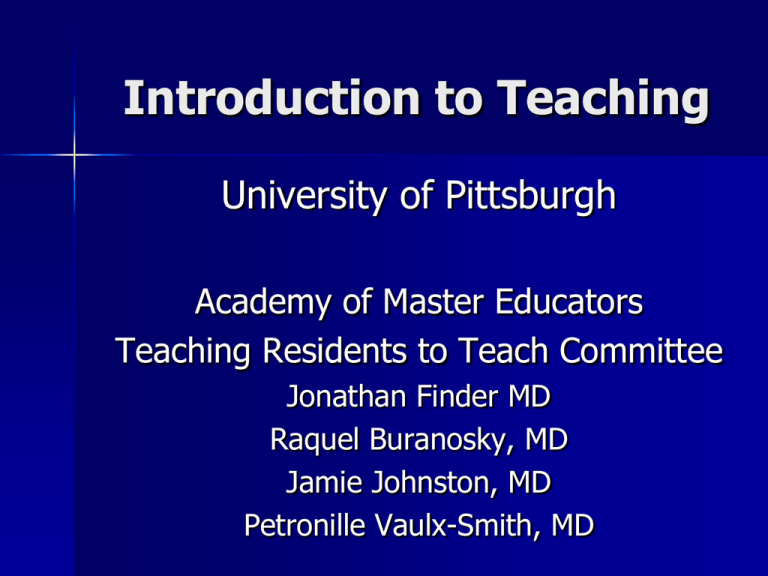
Introduction to Teaching University of Pittsburgh Academy of Master Educators Teaching Residents to Teach Committee Jonathan Finder MD Raquel Buranosky, MD Jamie Johnston, MD Petronille Vaulx-Smith, MD Academy of Master Educators Residents as Teachers Committee Jonathan Finder, MD – Professor of Pediatrics – Clinical Director, Pediatric Pulmonology Jason Rosenstock MD – Assistant Professor of Psychiatry – Director Med Student Education Raquel Buranosky, MD,MPH – Associate Professor of Medicine – Director, Internal Medicine Residency Peter Ferson, MD – Professor of Surgery Committee Members James Johnston, MD – Professor of Medicine – PD, Nephrology Fellowship – President, AME Rita M Patel MD – Professor & Vice-Chair, Anesthesiology – Clinical Procedures UPSOM Course Director – Associate Dean for GME Kathleen McIntyre-Seltman, MD – Professor of OB/GYN & Reproductive Sciences – Advisory Dean, UPSOM Petronilla Vaulx-Smith, MD, PhD – Assistant Professor of Psychiatry Basil Zitelli, MD – Professor of Pediatrics Introduction to Teaching Goal: To help incoming house staff 1) recognize the importance of teaching 2) understand basic do’s and don’ts 3) be open to further development of teaching skills Orientation Program Introduction to Teaching Why? Helps with patient care Makes you look good Learners expect it It’s required – ACGME Competencies – Program/Institutional Requirements Intro to Teaching: The APPLE Curriculum APPLE Curriculum – Application of Principles and Practice of Learning and Education Core – Fundamental principles of education – Teaching Opportunities – Assessment/Evaluation/Feedback Conduct of Session Brief introduction to teaching Case-Based Scenarios Reflection (Table Discussion) Open Discussion Summary – Teaching Points Agenda - 1 Core – Fundamental principles of education – Teaching Opportunities – Assessment/Evaluation/Feedback Dr. Vaulx-Smith Adult Learning Principles Adult learners: – Are goal-oriented (Why, What and How) – Are autonomous and self-directing – Have preexisting resources (life experiences) Make it relevant, practical & contextual (problem solving) Be respectful (safe learning environment) Motivate and reinforce Agenda - 2 Core – Fundamental principles of education – Teaching Opportunities – Assessment/Evaluation/Feedback “Teachable Moments” Not just a ‘lecture’ Modeling professional behavior Daily opportunities – Work rounds – Procedures – Ambulatory settings Pick your targets (can’t do it all) Be brief (“teaching on the fly”) What type of teaching useful? % Responses 70 60 A. 50 B. 40 30 C. 20 D. 10 0 A B C D High ------------------------------------------------Low MS Resident Prog Dir Procedures, Case Management, 5-min talks, Bedside Teaching Physical Diagnosis Rounds Lectures, PBL, Simulated Cases, Socratic questioning MS I & MS II courses *Students value case-based & bedside teaching over lectures. “The One Minute Preceptor” 1. 2. 3. 4. 5. Get a commitment Probe for supporting evidence Teach general rules and think out loud Tell your learner what he or she did right Correct the learner’s mistakes Irby, 1997 The One-Minute Preceptor: Microskills for Clinical Teaching SCENARIO #1 1. 2. Answer the following questions How can you use adult learning principles to improve the educational experience? Identify the teachable moments and critique what you saw Comments? 1. 2. 3. 4. 1 Minute Preceptor: 1 Get a commitment – Ask learner to articulate his/her own diagnosis or plan – Get him/her to commit to an answer (even if wrong) One Minute Preceptor 2 Probe for supporting evidence – Evaluate the learner’s knowledge/reasoning – Ask probing questions Ask why he/she thinks so Ask “what if …” scenarios Broader / deeper than learner’s answer One Minute Preceptor: 3 Teach general rules • Generalize from the case at hand • Give the learner a pearl /take home point • Point out how this case is same or different from the general rules Microskills of Teaching: 4 Reinforce what was done well • Provide positive feedback • “Catch them doing something right” One Minute Preceptor: 5 Correct errors • Provide constructive corrections and feedback Specific Targeted Recommendations for improvement The One Minute Preceptor Choose a single teachable point per encounter – Most generalizable (most useful) – Most important (don’t miss the life threatening diagnosis) – Targeted at learner’s area of weakness – Building on previous teachable point – Can be diagnosis, management, skill etc Agenda Core – Fundamental principles of education – Teaching Opportunities – Assessment/Evaluation/Feedback Dr. Buranosky Feedback vs. Evaluation Immediate Informal Objective Specific Improvement Formative Information Scheduled Formal Subjective Global Grade Summative Judgment RIME Evaluation Framework Reporter – Provides data – WBC count 15; chest x-ray infiltrate Interpreter – Integrates data – Differential diagnosis including pneumonia Manager – Implements – Treats with antibiotic, arranges hospital admission Educator – Teaches – Shows how individual data led to diagnosis of pneumonia and how to treat it SCENARIO #2 Answer the following questions: 1. How would you improve the feedback that was given? 2. Use the RIME System to assess the learner Comments? 1. 2. 3. 4. Feedback in the Clinical Setting Observe the learner Describe a notable aspect of performance Wait for a response Recommend a next step to enhance their performance Arrange for a retry Evaluation of Clinical Learners Reinforce what they are doing well Educate about areas in which improvement is possible Affirm your belief in their ability to follow this advice Check for their understanding by asking for a plan Commit to help Teaching Challenges The unmotivated student The unprofessional student Confrontation/Conflict Time constraints Navigating the learner/teacher role Intro to Teaching: Conclusions It’s important and you’ll do it regularly Make it relevant, practical Capitalize on teachable moments Use your new teaching skills (1 min. preceptor) Give timely feedback, assess with RIME Ask for help, more to come So Just Take the Plunge
